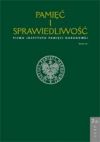Wokół problemu rezydentury NKWD w getcie warszawskim
On the problem of an NKVD residentura (residency) in the Ghetto of Warsaw, 1941–1942
Author(s): Piotr J. WróbelSubject(s): History
Published by: Instytut Pamięci Narodowej
Summary/Abstract: One of the most surprising aspects of the history of the Ghetto of Warsaw was that it constituted for some time a relatively safe refuge for anti-German conspiracies. By the end of 1941, a rumor appeared that the Ghetto had become a seat of the NKVD. Historians hotly debate this information. This article, an extension of a paper given during the 2003 conference on “The Holocaust and Intelligence” and a part of a larger project on “The Holocaust, Communism, and the Jews of Warsaw,” examines the issue of the Ghetto residentura. From the beginning of the war, the Jews participated in numerous underground organizations in Poland. Almost all leftist conspiracies created their centers in Warsaw and had their cells in its Ghetto. After the German attack against the Soviet Union, Polish communists intensified their activities. In January 1942, they were invited to the newly established Polish Workers’ Party, which also grew quickly in the Ghetto of Warsaw. The resistance led by the Polish Government-in-Exile kept an eye on the leftist groups. In 1943, it established the Civic Anticommunist Committee (Społeczny Komitet Antykomunistyczny). Its archive includes documents produced by Polish underground intelligence institutions active from 1939. The earliest report, from October 13, 1941, describes the activities of Colonel Glebov in the Ghetto of Warsaw. Previously, on September 6, 1941, General Stefan Grot-Rowecki, Commander-in-Chief of the Home Army, informed his supervisors in London that a number of Soviet parachutists were spotted in German-occupied Poland and that an NKVD Major Klebov hid in the Ghetto. Another document from the “strictly confidential personal papers” of StanisΠaw MikoΠajczyk, a Deputy Prime Minister of the Government-in-Exile, from September 20, 1941, describes “the activities of the Comintern’s agents on the Polish territories,” including a certain “Klebow/Clebow/ Glebow.” In May 1942, Polish resistance reported on a Red Army Commissar Klimkov working in Warsaw. After the destruction of the Ghetto of Warsaw in May 1943, new information about an NKVD residentura appeared. It included Jewish survivors but operated mostly on the outskirts of Warsaw and was dominated by Russians and Poles. Considering all the contextual elements of Warsaw’s situation in 1940 and 1941, it is likely that NKVD agents operated in the Ghetto. The intelligence operations in the Ghetto of Warsaw constitute a legitimate issue worthy of further study. Systematic research in the Russian archives can present a completely new picture of the Jewish communist resistance in Warsaw only sketched in this article.
Journal: Pamięć i Sprawiedliwość.
- Issue Year: 8/2005
- Issue No: 2
- Page Range: 197-216
- Page Count: 20
- Language: Polish

